Nightmare In a Small Town: The Mystery of Pont Saint Esprit: Part One

Introduction
Pont Saint Esprit is a small town located on the Rhone River in the South East of France.
It is famous as being the ancestral home of Jacqueline Kennedy [5].
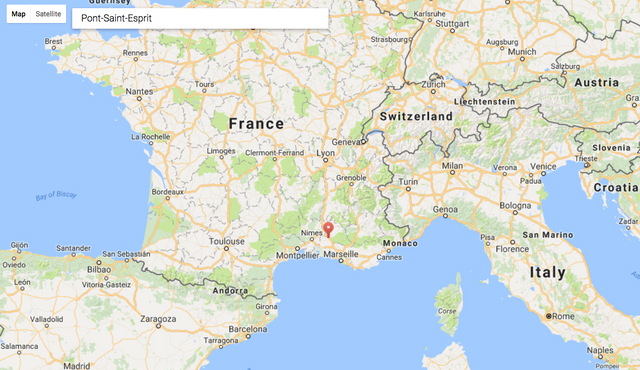
Red marker shows Pont Saint Esprit: Source Google Maps
In August of 1951 the picturesque French town became the site of a bizarre medical incident.
Reports circulated around the world that people in the town had suffered a bizarre malady which resulted in "madness" (as well as various physical symptoms) following the consumption of tainted bread.
There were reports of hallucinations, suicide attempts and violent delirium.
Up to 250 people were affected and due to the severity of the situation it was considered a national emergency.
The symptoms were reminiscent of a medieval malady known as "Mal des Ardents".
This was caused by contamination of food by a type of fungus called ergot and loosely translated it meant the "burning disease" [4].

Pont Saint Esprit today via Thinkstock
I have been interested in this case for some time and have seen it discussed in various places both online and in books from a very sensationalist and conspiratorial perspective.
For those who are not familiar with my blog I am a physician by training so will try to bring a more professional perspective to this discussion whilst attempting to keep it easy to understand for the lay person.
In this first post on the incident I would like to cover the events themselves.
In the next part I will be looking at the different theories which have been suggested to explain the events including a more in depth discussion of ergotism itself.
This is by necessity a long post so as always for those who are time restricted I will put a TLDR type summary in the Conclusion section.
So What Actually Happened?
The following video taken from a newsreel [3] at the time is a great summary of what happened. I don't think you even need to understand French to get the gist of it:
As I stated earlier a lot has been written about this incident. Much of it seems to be quite extreme and sensationalised.
This is made worse by the fact that we are now more than 65 years away from the events themselves and most people around at the time are either very elderly or deceased.
Having reviewed a lot of old newspaper archives and reports it is hard to find much primary evidence from someone on the scene.

Fortunately the local physician Dr Gabbai (and some colleagues at Montpellier Hospital) made a case report in the British Medical Journal which can give us a direct clinical picture of what was going on.
I have summarised their findings below:
Initial Symptoms
It is believed that the initial reports of problems started to emerge on or just after the 15th of August 1951:

Mood Disturbance and Digestive Problems
According to the physicians:
"The first symptoms appeared after a latent period of 6 to 48 hours. In this first phase, the symptoms were generalized, and consisted in a depressive state with anguish and slight agitation. After some hours the symptoms became more clearly defined, and most of the patients presented with digestive disturbances."
"Particularly notable was the state of nausea, with diffuse abdominal pain; less often noted were vomiting and diarrhoea (in about 30% of cases). There was often a sensation of distressing pharyngeal [throat] constriction."

Autonomic Disturbance
The physicians noted "disturbances of the autonomic nervous system" which accompanied the gastrointestinal problems.
The autonomic nervous system concerns the unconscious processes that control vital processes like breathing, heart rate temperature etc.
Patients were noted to be pale, with a slowed heart rate (bradycardia), and body temperatures were noted to be lowered (36.5-36.8°C).
Some patients experienced falls in blood pressure that coincided with fainting incidents.
Excessive salivation and dilated pupils (mydriasis) were also frequently noted.

Insomnia and Colic
After the first day or two people developed insomnia which lasted for several days.
This was accompanied by worsening of the abdominal symptoms particularly colicky abdominal pain, burning sensations and excessive sweating.
A "giddiness" and a "disagreeable" odour accompanied this which "struck the patient and his attendants".
Patients were noted to have "inconspicuous trembling of the extremities".

Visual Disturbances
They also had difficulties with visual accommodation - the ability to focus the eye - this likely related to the dilation of the pupil.
The main symptom that they complained of in this case was an inability to read.
If you have ever had your pupils dilated for an eye exam you will understand how blurred this can cause your vision to become.
Menstruation
Several women reported premature menstruation and one pregnant woman presented with "frank haemorrhages" (bleeding).

Children
It was noted that symptoms seemed to develop more rapidly in children but also seemed to subside more quickly.
Later and More Severe Symptoms
For the vast majority of the patients the symptoms were confined to those above and subsided after a few days.

More Severe Vascular Issues?
For others the "pallor and cold in the extremities" became worse.
These were accompanied by abnormal sensations such as burning, pins and needles, formication (insects crawling under the skin) and loss of sensation. There was also increased cramping of the calves.
Fainting attacks persisted and it was noted that in between these crises were hypertensive attacks where the blood pressure would rise dangerously high.
This was accompanied by weakening of the peripheral pulses (hands and feet).
To me, these signs and symptoms are suggestive of arterial constriction. They would also explain the cold extremities and altered sensations.
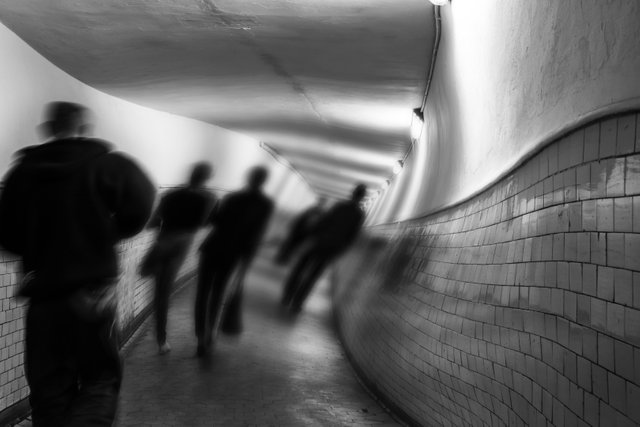
Delirium
Beyond these vascular symptoms there were also signs of excessive talkativeness, psychological and physical agitation and insomnia.
As evening fell visual hallucinations were also noted - a common feature of delirium.
According to the physicians symptoms of delirium appeared about 10-12 days after first onset of the suspected poisoning.
The delayed onset is interesting. It could indicate the accumulation of a toxic metabolite of a particular substance or some sort of delay in it interacting with the central nervous system/brain.
An alternative explanation is that it indicates accumulated damage over a period of time - for example lots of small strokes.
This would also likely result in an immune response and inflammation which could make any existing delirium worse.
It is also entirely possible that these kind of symptoms started earlier but initially patients were able to more successfully mask them in the initial stages.
Unfortunately medical technology was a lot more inferior at the time and so the investigating physicians lacked many of the tools we would have today to ascertain this.

The Hallucinations
Common themes of the visual hallucinations involved animals and flames.
The idea of flames is consistent with the reported physical sensations of burning that were likely caused by arteries becoming constricted and severely cutting off blood supply to the limbs.
This is a central feature of "mal des ardents" and gives it it's name as "the burning disease".
It is likely the physical sensations influenced the content of the hallucinations that people were experiencing.
They were also described as "fleeting" and sometimes mystical or macabre.
NB: This is also consistent with the hallucinations experienced in medieval incidents which often had spiritual/religious as well as macabre overtones.
In some cases these "visions" lead to people doing dangerous things like jumping out of a window.
Attempts at restraining patients for their own safety only served to make them more agitated. Muscular spasms were also noted.
Sweating and temperature rises accompanied these episodes once again suggesting autonomic disturbance.
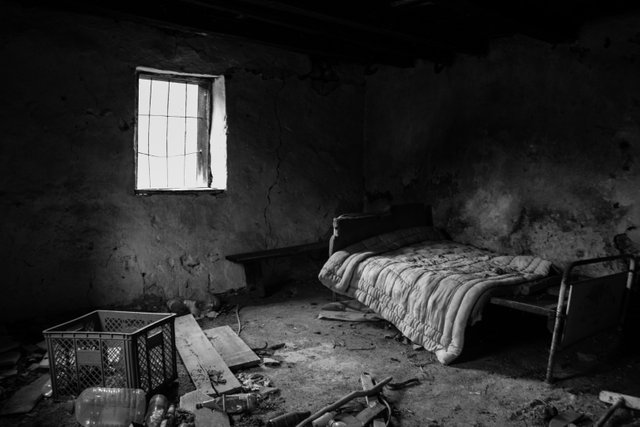
Seizures
2 patients developed "epileptiform convulsions" which were successfully controlled with barbiturates (an old type of sedative medication).
Urinalysis
Analysis of urine in these patients also showed blood (haematuria) and albumin (a protein which should not normally be present).
This could mean a number of things.
For example it could indicate infection, particularly within the urinary tract.
It could also suggest some kind of toxic insult directly to the kidneys - in essence making them more leaky. This will become more relevant in part 2 when we consider causes.

Fatalities
Of the four deaths that occurred, three of the patients were described as being "old and in poor health", one of which was a woman with hyperthyroidism.
The other was a 25 year old man described as being in good health. It is hard to comment on this without further information though.
Perhaps he had some undiagnosed pathology which was not well known at the time.
According to the physicians:
" They died in muscular spasm and in a state of cardiovascular collapse. The blood urea was raised to 150mg per 100ml. The woman showed at her death a moist gangrene of the toes."
These symptoms are consistent with extreme arterial spasm which could contribute towards death in a number of ways.
On the one hand it could deprive tissues of blood resulting in gangrene as reported.
It could also cause muscular damage. The raised urea could be a result of that.
It could also be due to kidney damage as a result of toxic muscle breakdown, direct action of the illness-causing toxin itself and/or infection (e.g. gangrene).
The Situation After 15 days

Overall the physicians reported about 150 people suffering from the more mild manifestations of illness, 25 had the more severe delirium and there were 4 (later 5) fatalities.
According to Gabai et al. :
Alimentary [food based] poison was immediately suspected because of the large number of people attacked. It was easy to incriminate the bread, the more so because animals which ate some of the poisoned bread died making convulsive movements. From the first, ergotism seemed very probable."
They submitted the report to the BMJ about 15 days after the start of the situation. Most patients had recovered but some with more severe illness were still suffering and in hospital.
Understandably the physicians felt it was too early to give a definite verdict on the cause:
"Now that we have gathered the documents together, 15 days after the poison was taken, it is still too soon to give a definite balance sheet."
"Nevertheless we can foresee the complete disappearance of the vascular disorders but we cannot say what the effect will be on the mind of some of the patients, in particular the minds of alcoholics who fell victim to the poison."
Note: - Ergot is a fungus which infects certain cereal crops and contains a variety of compounds (ergot alkaloids) which can cause these kind of mental and physical effects. I will cover this in more detail in part 2.
Newspaper Reports
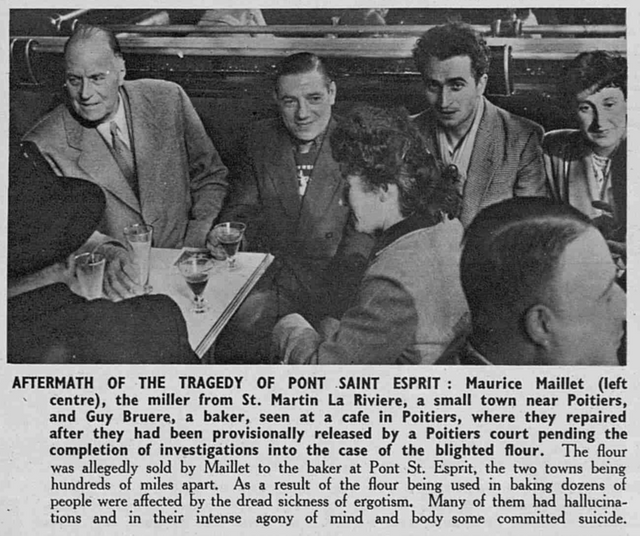
Image of Maurice Mallet: Source: The Sphere, November 17, 1951
These need to be taken with caution due to the possibility of sensationalism and misreporting but I thought it would be useful to cover at least some of them.
For example, despite what the newspaper clipping above implies I have yet to see confirmation that anyone actually died as a result of definite suicidal intent and although there are reports of life threatening actions, in light of the hallucinatory experiences/delirium it would be a stretch to presume it.
For example if you believe you are being chased by a tiger then you might try to escape by jumping out of a window.
That is not the same as being suicidal, you may merely think you have a better chance of survival that way - though it might serve the purposes of selling a newspaper to neglect that kind of detail.
I have used mainly US newspapers due to ease of access but it seems the exact same reports were replicated around the world presumably through syndication - some of the local British newspapers had the same stories.
It should also be noted that this is by no means complete and I have been unable to access all the archives due to physical and time constraints:
Charleston Gazette August the 29th 1951:
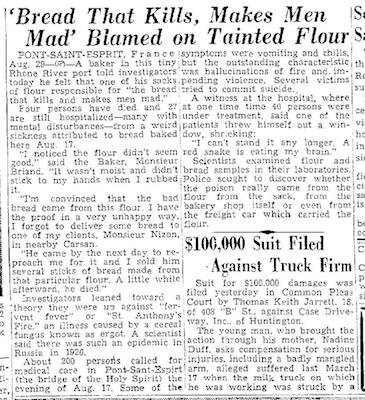
This contained some interesting information from the local baker Monsieur Briand:
A baker in this tiny Rhone River Port told investigators today he felt that one of his sacks of flour was responsible for the bread that kills and makes men mad.
"I noticed the flour didn't seem good. It wasn't moist and didn't stick to my hands when I rubbed it. I'm convinced that the bad bread came from this flour. I have the proof in a very unhappy way. I forgot to deliver some bread to one of my clients, Monsieur Nizon, in nearby Carsan. He came by the next day to reproach me for it and I sold him several sticks of bread made from that particular flour. A little while later he died."
This report also mentioned ergot as being suspected as the cause of the illness and it also linked it to medieval manifestations of ergotism known as "fervent fever" and "St Anthony's Fire".
Waukesha Daily Freeman from August the 29th 1951
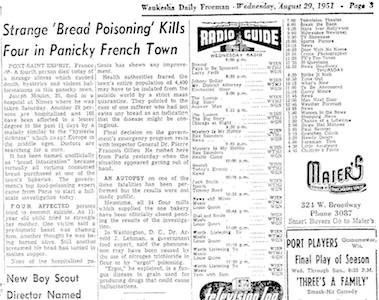
This paper added the following information:
- The younger fatality was reported as being 35 year old Joseph Moulin (which contradicts the previous age in the BMJ and other sources).
- There were 4 suicide attempts.
- An 11 year old child attempted to strangle her mother.
- One victim was claiming to be chased by a "prehistoric beast".
- One claiming to be burned alive and another "screaming his head turned to molten copper".
- 24 flour mills that had previously supplied the implicated bakery had been closed pending investigation.
- Dr Arnold J Lehman "a government food expert" in Washington DC suggested the most likely cause as being nitrogen trichloride or ergot poising - nitrogen trichloride was commonly used to treat flour in the early 20th century.
Blytheville Courier 31 August 1951:
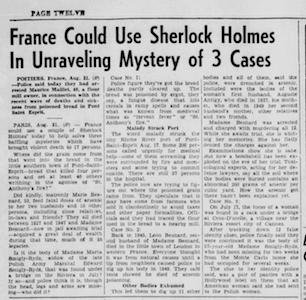
This reported:
- Flour Mill Owner Maurice Mallet (aged 40) arrested in connection with the incident.
- 37 people still in hospital.
Brazil Daily Times September 10th 1951:
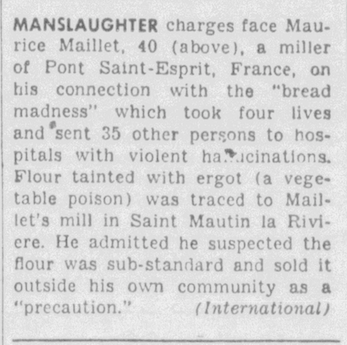
This reported:
- (Miller) Maurice Maillet was facing charges of manslaughter.
- Quote: "He admitted he suspected the flour was substandard and sold it outside his own community as a precaution".
Amarillo Sunday News Globe, September 16th 1951:

This reported:
- Fifth fatality - 79 year old Joseph Portal died in a psychiatric hospital.
- Bread was made of "spoiled flour" and baker and miller had been charged with involuntary homicide.
The Bluefield Telegraph in October 5th 1954:
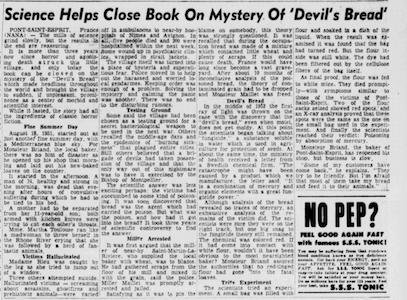
This news report was from 3 years after the events and so gave some useful conclusions to the episode as well as raising some more puzzling questions:
- Charges against Maillet were dismissed and he was freed.
- It is not clear exactly why - presumably tests on the bread did not reveal any source of toxin.
- The report also says that a "Swedish chemical firm" had contacted the Ministry of Health in France to report that they believed one of their fungicides may have been involved.
- I was unable to find any corroborating evidence of this. Further I believe this may be an erroneous report referring to the nearby Sandoz Labs (- notably Swiss rather than Swedish).
- Initial tests for mercury in the bread were negative but it was observed to not become mouldy which according to the report suggests the presence of a fungicide.
- Victims "remains" did contain mercury according to the report but I was not able to find any other sources to confirm this information though.
So to sum up as one often finds with news reports there are some contradictions and inconsistencies.
They do seem to confirm:
- The likelihood that there was something unusual with the bread.
- Ultimately there were 5 fatalities.
- Although the main suspected cause was ergot, there were alternative theories too.
I will return to this discussion in Part 2.
Conclusion

In summary it seems that the people of Pont Saint Esprit were struck down by a mysterious illness with both physical and mental symptoms.
The physical symptoms seemed to comprise gastrointestinal problems, autonomic disturbances and vascular problems.
Mental symptoms consisted of agitation, depression and insomnia.
In more severe cases there were reports of hallucinations, delirium and seizures which were also accompanied by fainting spells.
Although most of the estimated 150-250 cases resolved within a few weeks there were at least 25 people who suffered from a more severe and prolonged syndrome, including 5 fatalities.
The one common factor for all the cases was consumption of a particular batch of bread from a local bakery.
Although the baker and miller who supplied the bread were initially charged with manslaughter these charges were later dropped (presumably due to insufficient evidence).
The symptoms resembled past outbreaks of ergotism but there were a number of theories circulating at the time.
I will consider these in more detail in my next post on this subject.
References
Gabbai, Lisbonne, and Pourquier. 1951. “Ergot Poisoning at Pont St. Esprit.” British Medical Journal 2 (4732): 650–51.
Wikipedia contributors. 2017. “1951 Pont-Saint-Esprit Mass Poisoning.” Wikipedia, The Free Encyclopedia. January 30. https://en.wikipedia.org/w/index.php?title=1951_Pont-Saint-Esprit_mass_poisoning&oldid=762680707.
Institut National de l’Audiovisuel – Ina.fr. 2017. L’AFFAIRE DE PONT SAINT ESPRIT - Vidéo Ina.fr. Accessed January 31. http://www.ina.fr/video/AFE85004211.
Schott, B., C. Fischer‐Perroudon, and M. Boucher. 1996. “From Morvan’s Fibrillary Chorea to the ‘mal Des Ardents.’” Journal of the History of the Neurosciences 5 (3): 265–73.
Wikipedia contributors. 2017. “Pont-Saint-Esprit.” Wikipedia, The Free Encyclopedia. January 29. https://en.wikipedia.org/w/index.php?title=Pont-Saint-Esprit&oldid=762513716.
Thank you for reading

Before you go have you filled in the Coinbase form to list STEEM? It only takes a few seconds. THIS POST shows you how.
If you like my work please follow me and check out my blog - @thecryptofiend
Newspaper clippings are taken from various online archives using my own personal accounts. These include newspaperarchive.com and www.britishnewspaperarchive.co.uk - specific newspaper sources are listed in the article. Uncredited Images are taken from my personal Thinkstock Photography account. More information can be provided on request.

I remember reading about ergotism that was prevalent during Medieval times that affected sometimes thousands at a time. It was from ergot, the mold that grows on rye flour. It was also thought to be the cause of St. Vitus dance, a malady that caused twitching and convulsive behavior. Really good article.
Yep this, I came here to talk about St. Vitus dance and the similarities to what is reported here. However you beat me to it!
Thanks yes and spot on and I will be talking about it more in the second part!
Wow! Fabulous post. Thank you for sharing. Follow for sure.

Thanks:)
I thought there were some similarities to Lyme disease with the symptoms.
Perhaps there was some kind of unknown pathogenic bacteria in the bread.
It's possible. In a sense you can think of ergot as microbe too. The symptoms did eventually resolve except for those that died of course.
Scary stuff when you think that things so tiny can be so deadly.
Yes. A pinhead worth of botulinim toxin could kill the entire human population of the earth.
Oh my God! Not sure I wanted to know that lol!
Glad Im not a doctor lol!
Not sure I would sleep at night.
Respect.
Interesting post! I will wait to see if you discuss what I expect in your second part! :D
Thanks - we will have to see. I'm still waiting on getting some information which may or may not come. That's all I can say right now.
That would have been scary.
I gather you didn't like my latest post... sorry if I offended you :(
What do you mean? I haven't actually seen your post yet.
she has you on her list of great Steemit writers ;)
I saw you had voted, thought I had said something I shouldn't have.
No I don't always comment immediately or at all. Sometimes I vote and then put things aside to read later so don't be concerned if that happens.
Just me being paranoid again..it will pass lol
I am familiar with this event, as I heard about it through something else I watched a little while back. I shall not mention it however, because you want to go into theories in the second post and I don't think it would be helpful to mention one now.
I will say that some of the hallucinations sound horrifying. Your own mind knows your fears better than anyone, and if you include your subconscious mind, that is probably aware of things that you don't even know you are terrified of.
It must have been literally the worst experience ever for some of those people who were subjected to a living nightmare, written and directed by the one who knows how to torture them the most--their very self.
Thanks I'm not sure I will have a conclusive answer at the end though. I think also the combination of the hallucinations with the intense burning pain must have been absolute hell!
Yes, quite literally..
Quite the mystery!
Yes :)
I have read about Saint Anthony's Fire in a late 17th-century Dutch document I came across researching my family history. I was going to send it to you but I can't seem to find it ...
No problem but if you do find it please do - I might be able to use it in part 2!
Great Post. The pictures were truly eye-catching :))
Thank you:)
This post has been ranked within the top 25 most undervalued posts in the first half of Feb 10. We estimate that this post is undervalued by $7.67 as compared to a scenario in which every voter had an equal say.
See the full rankings and details in The Daily Tribune: Feb 10 - Part I. You can also read about some of our methodology, data analysis and technical details in our initial post.
If you are the author and would prefer not to receive these comments, simply reply "Stop" to this comment.
Thank you:)